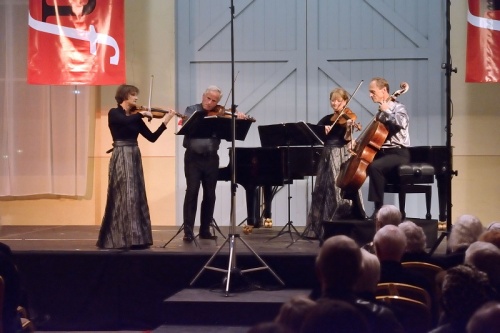IN A CONCERT full of contrasting pieces and compositional styles, this showing was a splendid start in the run down to the finale in this 21st Canberra International Music Festival.
Two ensembles, the Tinalley String Quartet and the New Zealand String Quartet, made up the double, augmented by Roland Peelman’s The Song Company.Franz Schubert was a contemporary of Beethoven, and his String Quartet No 12 “Quartettsatz”, written in 1820, is actually the first movement of a work he never completed. The youthful Tinalley gave it a lively and energetic performance. Except for the cellist, the musicians stood giving them freedom to move with the piece and give it that extra dollop of vitality. There was an occasional lapse of balance, but overall they gave a very assured account of the piece, with fabulous expression, creating lovely light and shade.
The Russian composer, Sergei Rachmaninov was born in the latter part of the Romantic period and it’s his four piano concerti for which he is best known. But he wrote much more, including the “Romance and Scherzo for String Quartet”, from the early 1890s. It is full of the lushness you’d expect from that period and the New Zealand String Quartet were lushness personified, creating beautifully balanced muted tones in the first movement and all the lightness, brightness and playfulness expected in the scherzo. It was a charming, delightful performance.
After such romantic lushness we ventured into the modernist realm, with the Australian premiere performance of “Cries: A Border Town”, by New Zealand composer, Jack Body (b 1944). The New Zealand String Quartet was joined by The Song Company, with Peelman directing proceedings.
It’s the story of a Jewish man in war time who, wanting to cross a border but being denied the chance, suicides rather than submitting to the Nazis. The piece contrasts this with human mortality in which we all face a border we do not want to cross but inevitably must.
The music, whilst quite abstract for both instrumentalists and singers, fits perfectly together. It requires great control which Peelman and his forces achieved superbly. The ending was particularly effective with the vocalists pronouncing “It is time to embrace the ocean” and then fading away with the sounds of us embracing the sea … or perhaps the sea embracing us.
Then came the world premiere performance of “Common Ground” a work not for double but for two string quartets by British-Australian composer and music presenter Andrew Ford, who was in the audience. It was almost a case of string quartet face-off with the two ensembles standing opposite each other in an arc with the two cellos in the middle. It has an intriguing mix of very modernistic sounds, including the harmonics achieved by very light fingering and bowing, and more traditional sounds in fact inspired by Mendelssohn.The two first violins would play together; one would play the harmonics, the other the melody, then the seconds, then the violas and then the cellos. Then they would swap. Then there would be various combinations across the two ensembles. Then the two quartets would do the same. Thus it was, backwards and forwards, round and about all the way through.
Quite simply, the ensemble played it brilliantly achieving, as was crucial, a fine balance but giving just the right amount of prominence to individual instruments or combinations as required.
The composer was pleased.
To finish the program we went to Mendelssohn himself, who lived less than 40 years but really was the one who took music from the classical period and turned it on its head in the romantic period. He wrote his Octet for Strings Opus 20 in 1825 when he was just 16 years of age.
Unlike “Common Ground”, Mendelssohn’s Octet is very much written for eight string players – four violins, two violas and two cellos, grouped together as they would be in an orchestral setting.
The Tinalley String Quartet and the New Zealand String Quartet combined to deliver an incredible performance of this most lovely work. It started off lively and assertively, moving into an almost laid-back leisurely phase, then through a playful scherzo and finally racing off in a spirited final movement.
They created all the typically wild mood swings of youth, again made all the more energetic by standing. The rhythmic scherzo movement, in particular, had my feet tapping uncontrollably.
A standing ovation and three curtain calls was the result for this superb group of musicians whose versatility in playing these very contrasting pieces was extraordinary.
The post Review / Contrasting pieces inspire standing ovation appeared first on Canberra CityNews.

